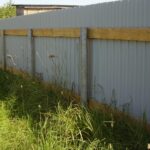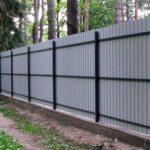The professional sheet in the construction of fences is attached to supports made of different materials. The owners assemble the fence posts from the corrugated board on their own in order to save on paying for the work of specialists. The installation process is simple, the technology depends on the material of the rack, the characteristics of the soil. Correct installation of the pillars will ensure the strength, stability of the fence, and careful marking will help to avoid waste of material.
- Fence construction made of profiled sheet
- Pole material
- Calculation of support racks
- Layout and excavation
- Foundation for a fence made of corrugated board
- Installation of pillars
- Installation of the lag and installation of the profiled sheet on the frame
- Errors when installing a fence from corrugated board
Fence construction made of profiled sheet
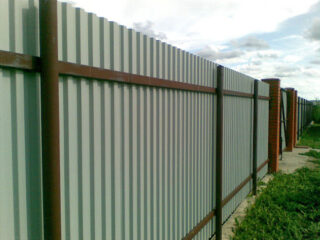
The extended structure includes pillars fixed in the ground or on the foundation, connecting joists, profiled sheet panels. If the fence does not exceed 1.5 m, the logs are placed at the top and bottom, and at a higher height, an intermediate beam is placed.
There are fences depending on the type of construction:
- Solid fences. In this case, the sheets of the profiled sheet cover the pillars. This type belongs to the lightweight category.
- Sectional. Each span is fixed between two supports. The length of the filling is determined by the relief, the length of the section is influenced by the number of turns, the presence of gates and wickets, as well as the aesthetic perception of the structure.
Supports in the foundation, included in the structure of the base, increase the reliability of the fence, resistance to wind. The foundation closes the bottom gap under the fence, reduces the blowing of dust, debris, water from other areas and the road.
Free-standing pillars are not connected by a base; such a budget structure is not recommended with a high fence height. On the arc side, unconnected pillars allow water to circulate freely in the surface layer, which is important for heaving, floating and loose soils with high humidity.
Pole material
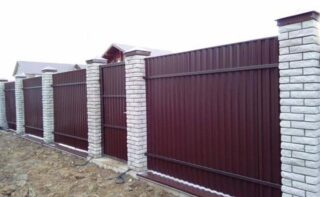
The supports must be strong, withstand the weight of the corrugated board, as well as the action of the side load from the wind. The material should not decompose from atmospheric influences, moisture, corrosion.
Supports are made of materials:
- brick, stone;
- wood;
- metal;
- asbestos cement;
- reinforced concrete;
- plastic.
Stone and brick varieties are built on a strip foundation of reinforced concrete, rubble. Under the pillars, the depth of the foundation is increased, sometimes separate racks made of other materials are concreted into such pits.
The technology of installing a corrugated sheet fence on wooden posts involves pre-impregnation with protective agents against decay, moisture absorption, combustion and microorganisms. Such supports do not last long. Metal poles made of pipes, channels, professional pipes also corrode, therefore they require processing and painting.
Asbestos-cement pipes are not destroyed by soil moisture, the supports are concreted in separate pits. For concrete racks, ready-made prefabricated longitudinal elements are taken, they are placed on the foundation, or concreted in it.
Calculation of support racks
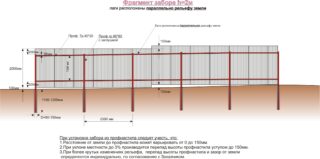
They draw up a draft fence, which shows the passage of the fence line, the location of access roads, trees. Then the length of the broken sections, if any, of turns, of the input group is determined. This information is applied to the drawing. The elevation marks of the soil matter, which requires a change in the height of the fence at each subsequent site, therefore, additional supports must be installed.
General principles for calculating the number of fence supports from a profiled sheet:
- For a continuous version, the total length is divided by the design span length (usually 2 - 3 m), taking into account the unevenness of the relief.
- For sectional fencing, the width of the post and the size of the section from the profiled sheet are taken into account. If the waves are placed vertically, then a distance is made between the posts, which is a multiple of the useful width of the sheet.
Racks should be placed at the corners of the fence, when cornering, even if the angle is small. Supports are provided at the installation site of the gate and wicket. Sometimes the passage is combined with the passage, then only two stands are required.
Layout and excavation
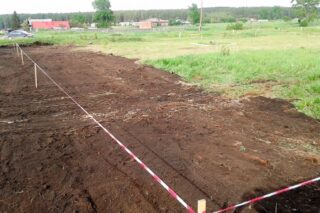
The fencing device from the profiled sheet begins by pulling the cord along the fence line. Use metal pieces of reinforcement 50-60 mm long or wooden pegs with a pointed end. Versts are driven in at each angle of the trajectory change. To arrange the foundation, double lacing is pulled along the width of the trench.
Excavation work begins with leveling the ground to reduce unevenness. Subsequent technological stages:
- dig a trench under the tape base;
- in the places where the pillars are installed, separate pits are made to a depth of 1.0 - 1.2 m;
- in the case of individual pillars (steel, asbestos cement, plastic), they dig holes with a garden drill;
- the bottom of the trench and pits are leveled;
- from below, a sand-crushed stone pillow is performed.
An excavator is used to dig long trenches, and small volumes are dug by hand. At the bottom, a layer of sand and crushed stone is poured with a thickness of 10 and 7 centimeters, respectively.
Foundation for a fence made of corrugated board
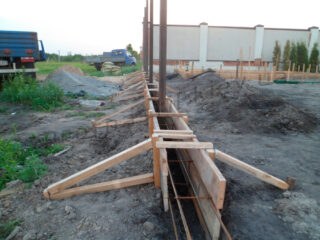
The base is made flush with the ground or raised above the surface to a height of 15 - 25 cm. In both cases, formwork is placed from boards, boards, OSB slabs. The walls are burst with bars or slats so that the concrete with its mass does not collapse the structure. The foundation is also laid out of rubble stones, red bricks on a cement-sand mortar.
Work order:
- a layer of waterproofing (roofing felt) is installed in the formwork so that the edges protrude 10-15 cm above the ground;
- longitudinally put reinforcement with a diameter of 8 - 12 mm, the rods should not reach the edge of the formwork by 5 cm from the bottom, from above and from the sides;
- pour the solution.
When concreting, electric vibrators are used to force out air bubbles. The gaps between the reinforcing bars are filled with a trowel. Use concrete in a concentration of 1: 3: 5 (cement, sand, crushed stone, respectively). After pouring, the surface is covered with polyethylene.
Concrete gains strength for 28 days, but further work can be carried out for 15 - 17 days.
Installation of pillars
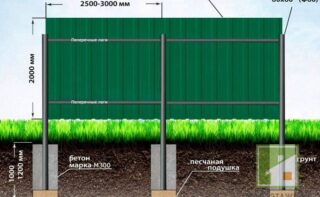
Usually, for a fence made of corrugated board with a height of 1.5 - 2.5 m, the supports are dug in to a depth of about a meter, while the foundation can be strip or pile. Pits for posts are dug, drilled, you can buy ready-made posts with a pile tip to twist.
Arrangement of supports made of different materials:
- brick and rubble pillars are laid on a concrete base;
- supports made of steel, wooden, asbestos-cement pipes are concreted in the main foundation or in separate pits;
- reinforced concrete racks are installed on the foundation, mounting loops are joined by welding.
Concreting in pits is used more often. For this, the underground part of metal, wooden racks is prepared in order to reduce the influence of moisture. Steel parts are treated with an anti-corrosion agent, before immersion they are coated with molten resin, bitumen 3 times.
Wooden pillars in the lower part are impregnated with heated linseed oil, coated with bitumen. They practice winding the underground part with layers of roofing material. Sometimes the bottom is scorched with a gas torch or blowtorch fire.
Installation of the lag and installation of the profiled sheet on the frame
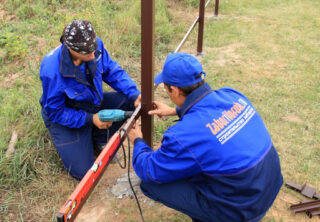
The lags are designed to strengthen the support posts; together with the posts, they form a frame for fixing the corrugated sheets.
Lags are installed in two ways:
- fixed longitudinally to the pillars from the outside, profiled sheet panels are installed on them (solid fence);
- a frame is built in the form of a frame, into which filling sheets are inserted, and the cards themselves are fixed between the pillars along the central line.
Usually, metal serves as the material for the manufacture of lags; wooden bars are rarely used. Support beams are welded to steel supports, and other fastening methods are used to posts made of a different material. Metal embedded parts are inserted into the brickwork in order to weld the logs. They are fixed to asbestos-cement with clamps, special holders in the form of plates are attached to reinforced concrete racks with dowels.
Profiled sheets are fixed to the beams with self-tapping screws for metal with rubberized gaskets under the caps. On a solid fence, the strips are fixed outside the lag. Sectional infills are installed in frames from a corner. The sheets are fixed in the lower (adjacent to the surface) wave.
Errors when installing a fence from corrugated board
Sometimes the sheet begins to be attached to the lag, starting from the end. Correct fixation involves the first fixing in the center, then alternately moving to the edges. If the sheets need to be joined together, they are fixed through the upper wave with an overlap.
Plugs are placed on the upper ends to protect the pillars from sticking snow and getting it inside the racks from the pipes. On top of the edge of the profiled sheet, protective strips are also provided, which are purchased along with the main material.
You cannot cut the corrugated board with a grinder, since the protective layer at the cutting site is broken, and sparks from the tool also burn defects in the coating of the sheets. It is better to use a circular saw or nibblers, and immediately paint over the cut points with spray paint sold with the profiled sheet.


